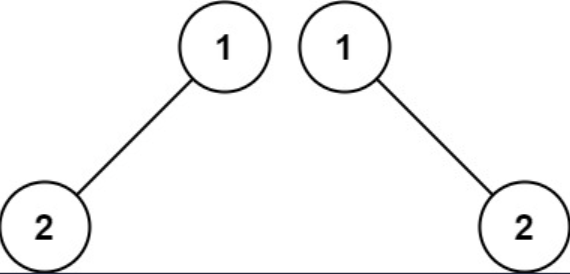2024/1/22大约 2 分钟
一、题目描述
给你两棵二叉树的根节点p和q,编写一个函数来检验这两棵树是否相同。
如果两个树在结构上相同,并且节点具有相同的值,则认为它们是相同的。
示例 1
输入: p = [1, 2, 3], q = [1, 2, 3]
输出: true
示例 2
输入: p = [1, 2], q = [1, null, 2]
输出: false
示例 3
输入: p = [1, 2, 1], q = [1, 1, 2]
输出: false
提示
- 两棵树上的节点数目都在范围
[0, 100]内 -10⁴ <= Node.val <= 10⁴
相关主题
- 树
- 深度优先搜索
- 广度优先搜索
- 二叉树
二、题解
Rust节点定义
#[derive(Debug, PartialEq, Eq)]
pub struct TreeNode {
pub val: i32,
pub left: Option<Rc<RefCell<TreeNode>>>,
pub right: Option<Rc<RefCell<TreeNode>>>,
}
impl TreeNode {
#[inline]
pub fn new(val: i32) -> Self {
TreeNode {
val,
left: None,
right: None,
}
}
}Java节点定义
public class TreeNode {
int val;
TreeNode left;
TreeNode right;
TreeNode() {}
TreeNode(int val) { this.val = val; }
TreeNode(int val, TreeNode left, TreeNode right) {
this.val = val;
this.left = left;
this.right = right;
}
}方法 1: 深度优先搜索
Rust
pub fn is_same_tree(p: Option<Rc<RefCell<TreeNode>>>, q: Option<Rc<RefCell<TreeNode>>>) -> bool {
//Self::dfs_recur(p, q)
Self::dfs_iter(p, q)
}
fn dfs_recur(p: Option<Rc<RefCell<TreeNode>>>, q: Option<Rc<RefCell<TreeNode>>>) -> bool {
const COMPARE: fn(Option<Rc<RefCell<TreeNode>>>, Option<Rc<RefCell<TreeNode>>>) -> bool =
|p, q| match (p, q) {
(None, None) => true,
(Some(p), Some(q)) => {
if p.borrow().val != q.borrow().val {
return false;
}
COMPARE(p.borrow_mut().left.take(), q.borrow_mut().left.take())
&& COMPARE(p.borrow_mut().right.take(), q.borrow_mut().right.take())
}
_ => false,
};
COMPARE(p, q)
}
fn dfs_iter(p: Option<Rc<RefCell<TreeNode>>>, q: Option<Rc<RefCell<TreeNode>>>) -> bool {
let mut stack = vec![(p, q)];
while let Some((p, q)) = stack.pop() {
match (p, q) {
(None, None) => {}
(Some(p), Some(q)) => {
if p.borrow().val != q.borrow().val {
return false;
}
stack.push((p.borrow_mut().right.take(), q.borrow_mut().right.take()));
stack.push((p.borrow_mut().left.take(), q.borrow_mut().left.take()));
}
_ => return false,
}
}
true
}Java
public boolean isSameTree(TreeNode p, TreeNode q) {
//return this.dfsRecur(p, q);
return this.dfsIter(p, q);
}
BiFunction<TreeNode, TreeNode, Boolean> compare = (p, q) -> {
if (p == null && q == null) {
return true;
} else if (p != null && q != null) {
if (p.val != q.val) {
return false;
}
return this.compare.apply(p.left, q.left)
&& this.compare.apply(p.right, q.right);
} else {
return false;
}
};
boolean dfsRecur(TreeNode p, TreeNode q) {
return this.compare.apply(p, q);
}
boolean dfsIter(TreeNode _p, TreeNode _q) {
Deque<TreeNode[]> stack = new ArrayDeque<>() {{
this.push(new TreeNode[]{_p, _q});
}};
while (!stack.isEmpty()) {
TreeNode[] nodes = stack.pop();
TreeNode p = nodes[0];
TreeNode q = nodes[1];
if (p != null && q != null) {
if (p.val != q.val) {
return false;
}
stack.push(new TreeNode[]{p.right, q.right});
stack.push(new TreeNode[]{p.left, q.left});
} else {
if (!(p == null && q == null)) {
return false;
}
}
}
return true;
}方法 2: 广度优先搜索
Rust
pub fn is_same_tree(p: Option<Rc<RefCell<TreeNode>>>, q: Option<Rc<RefCell<TreeNode>>>) -> bool {
Self::bfs_iter(p, q)
}
fn bfs_iter(p: Option<Rc<RefCell<TreeNode>>>, q: Option<Rc<RefCell<TreeNode>>>) -> bool {
let mut queue = VecDeque::from([(p, q)]);
while let Some((p, q)) = queue.pop_front() {
match (p, q) {
(None, None) => {}
(Some(p), Some(q)) => {
if p.borrow().val != q.borrow().val {
return false;
}
queue.push_back((p.borrow_mut().left.take(), q.borrow_mut().left.take()));
queue.push_back((p.borrow_mut().right.take(), q.borrow_mut().right.take()));
}
_ => return false,
}
}
true
}Java
public boolean isSameTree(TreeNode p, TreeNode q) {
return this.bfsIter(p, q);
}
boolean bfsIter(TreeNode _p, TreeNode _q) {
Deque<TreeNode[]> queue = new ArrayDeque<>() {{
this.addLast(new TreeNode[]{_p, _q});
}};
while (!queue.isEmpty()) {
TreeNode[] nodes = queue.removeFirst();
TreeNode p = nodes[0];
TreeNode q = nodes[1];
if (p != null && q != null) {
if (p.val != q.val) {
return false;
}
queue.addLast(new TreeNode[]{p.left, q.left});
queue.addLast(new TreeNode[]{p.right, q.right});
} else {
if (!(p == null && q == null)) {
return false;
}
}
}
return true;
}